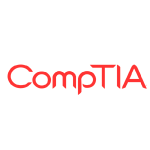COMPTIA A+ CERTIFICATION EXAM : CORE 1 (220-1001)
Course Overview
CompTIA A+ certified professionals are proven problem solvers. They support today’s core technologies from security to cloud to data management and more. CompTIA A+ is the industry standard for launching IT careers into today’s digital world. It is the only industry recognized credential with performance-based items to prove pros can think on their feet to perform critical IT support tasks in the moment. It is trusted by employers around the world to identify the go-to person in endpoint management and technical support roles. CompTIA A+ is regularly re-invented by IT experts to ensure that it validates the core skills and abilities demanded in the workplace.

Course Objectives
The Official CompTIA A+ Core 1 Study Guide (220-1001) has been developed by CompTIA for the CompTIA certification candidate. Rigorously evaluated by third party subject matter experts to validate adequate coverage of the Core 1 exam objectives, the Official CompTIA A+ Core 1 Study Guide teaches the essential skills and information required for the CompTIA certification exam (220-1001).
After reading this study guide you will understand how to:
- Install and configure PC system unit components and peripheral devices.
- Install, configure, and troubleshoot display, multimedia devices, storage devices, and internal system components.
- Explain network infrastructure concepts.
- Configure and troubleshoot network connections.
- Implement client virtualization.
- Support and troubleshoot laptops, mobile devices and print devices.
.
Course Prequisites
To learn with the CompTIA A+ Certification Study Guides and prepare for your exam, you should have successfully completed the CompTIA IT Fundamentals course or have some basic experience using a PC, Windows, and browsing the web. Specifically, we recommend that you have the following skills and knowledge before starting this course:
- Recognize the main components of a PC as well as storage media such as USB drives and DVD.
- Start the computer and navigate the operating system desktop.
- Use Windows Explorer to create directories and subdirectories and manage files.
- Use a web browser to view websites.
Target Audience
This course is designed for individuals who have basic computer user skills and who are interested in obtaining a job as an entry-level IT technician. This course is also designed for students who are seeking the CompTIA A+ certification and who want to prepare for the CompTIA A+ Core 1 220-1001 Certification Exam.
Course Outline
Lesson 1: Installing and Configuring PC Components
- Topic A: Use Appropriate Safety Procedures
- Topic B: PC Components
- Topic C: Common Connection Interfaces
- Topic D: Install Peripheral Devices
- Topic E: Troubleshooting Methodology
Lesson 2: Installing, Configuring, and Troubleshooting Display and Multimedia Devices
- Topic A: Install and Configure Display Devices
- Topic B: Troubleshoot Display Devices
- Topic C: Install and Configure Multimedia Devices
Lesson 3: Installing, Configuring, and Troubleshooting Storage Devices
- Topic A: Install System Memory
- Topic B: Install and Configure Mass Storage Devices
- Topic C: Install and Configure Removable Storage
- Topic D: Configure RAID
- Topic E: Troubleshoot Storage Devices
Lesson 4: Installing, Configuring, and Troubleshooting Internal System Components
- Topic A: Install and Upgrade CPUs
- Topic B: Configure and Update BIOS/UEFI
- Topic C: Install Power Supplies
- Topic D: Troubleshoot Internal System Components
- Topic E: Configure a Custom PC
Lesson 5: Network Infrastructure Concepts
- Topic A: Wired Networks
- Topic B: Network Hardware Devices
- Topic C: Wireless Networks
- Topic D: Internet Connection Types
- Topic E: Network Configuration Concepts
- Topic F: Network Services
Lesson 6: Configuring and Troubleshooting Networks
- Topic A: Configure Network Connection Settings
- Topic B: Install and Configure SOHO Networks
- Topic C: Configure SOHO Network Security
- Topic D: Configure Remote Access
- Topic E: Troubleshoot Network Connections
- Topic F: Install and Configure IoT Devices
Lesson 7: Implementing Client Virtualization and Cloud Computing
- Topic A: Configure Client-Side Virtualization
- Topic B: Cloud Computing Concepts
Lesson 8: Supporting and Troubleshooting Laptops
- Topic A: Use Laptop Features
- Topic B: Install and Configure Laptop Hardware
- Topic C: Troubleshoot Common Laptop Issues
Lesson 9: Supporting and Troubleshooting Mobile Devices
- Topic A: Mobile Device Types
- Topic B: Connect and Configure Mobile Device Accessories
- Topic C: Configure Mobile Device Network Connectivity
- Topic D: Support Mobile Apps
Lesson 10: Installing, Configuring, and Troubleshooting Print Devices
- Topic A: Maintain Laser Printers
- Topic B: Maintain Inkjet Printers
- Topic C: Maintain Impact, Thermal, and 3D Printers
- Topic D: Install and Configure Printers
- Topic E: Troubleshoot Print Device Issues
- Topic F: Install and Configure Imaging Devices
What Our Students Have to Say


